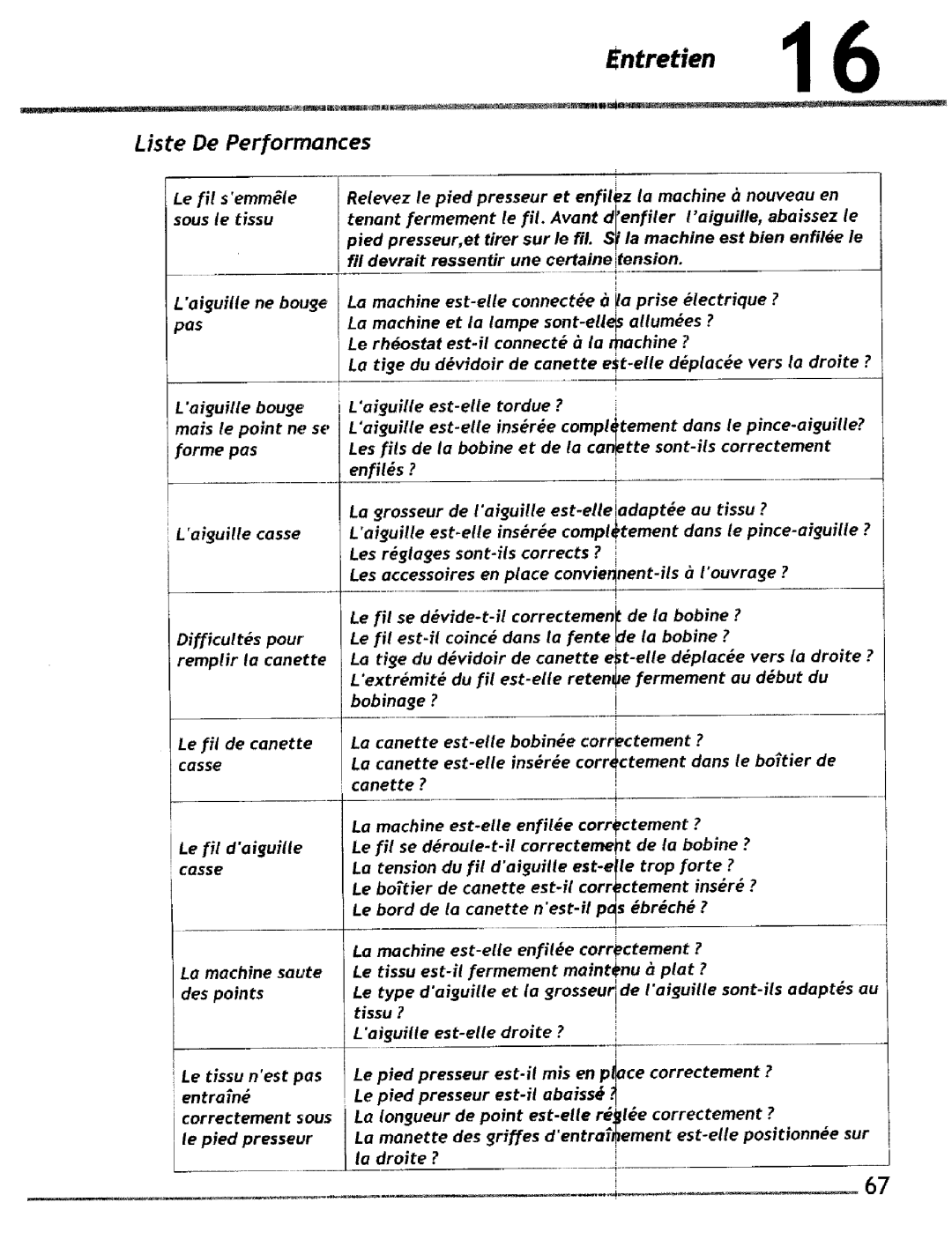Inspiration,M
Singer
ITabLe Contents
Remonter le fi! de canette Points Droits
Boutonniere Etape Surjeter Une couture Ou un bord Points
Couture Iaiguille
Optionelle
Qutando e! prensatelas de acoplamiento rdpiclo
Insertando y quitando la bobina Ensartando La mdquina
Tomando e hfto de ta bobina
Puntada
Ii!i!iJiZ!i!iliiii!il/1
Important Safety Instructions
OiJdes a#rosols sont utiliss ou de
Consignes de scurit importantes
Pas la machine clansles lieux
Esta mdquina ha sido desarrollada para uso domstico
AsegJrese de que el voltaje de ta clavija
Parts / Pices / Partes
359102
LJL
FaRes connaissance avec votre machine L
Boutonrototif de largeur du point
Boutonrotatif de
S61ecteurde point
Seector de posfd6n de In auja
Zurcido Y monogramas
Accessories / Accessoires / Accessories
Faites connaissance avec votre machine L
Learnin how to set the machine for the different stitches
Learning how to set the machine for the different stitches
Comment rgler ta machine pour/es diffrents points
Comment rgler la machine pour les diffrents points
Correctement
Page
Importante
Rheostat
Relever la poign#e pour transporter la machine
Levantando la asa Branchement de la machine
Branchement de la machine Conectando la Mquina
Para America del Norte
Aspectos bdsicos de la mquina
Changing needles / Changement daiguille I Cambiando agujas
Utilisez des aiuilles Singer uniquement
Aboissez le pied presseur
Dons la position la plus haute
Cambiando el prensatelas de colocacion instantdnea
Tournez le volant vers vous jusqu ce que Iaiguille soit
Colocando el prensateas de colocacibn instantdnea
Aspectos b6sicos de la rn6quina
Mettre en place le pied presseur enclenche
Aspectos b6sicos de la mdqufna
Changer le pied presseur sur talon visser
Pied presseur, le pied presseur et le
Talon De pied Presseur
Aspectos b6sicos de la m6quina
Retirer et remettre en place, le bras fibre
Aspectos bsicos de la mdquina
Abaisse 9rifles
Bajando los dientes impelentes
Impelente
Aspectos bsicos de la m6quina
Tension du f!i
Aspectos bsicos de la mquina
Tableau des Tissus, ills et
Aiguilles
Tpoi
Enf!lage de ia machine
Ensartando la M6quina
Remplssage de la canette Devanondo la bobina
Relevez le pied presseur
Enilage de la machine Ensartando la M6quina
Faites passer le il par un des trous de
La canette conormment
Iillustration en laissant dpasser un
Ensartando la M6quina
Enilage de la machine
Poussez la canette sur la tige du dvidoir de canette
Poussez la tige du dvidoir compltement vers to droite
Enfilage de ia machine Ensartando la Mquina
Vers vous jusqu ce que
Iaiguille soit dans la position la plus haute
De pied presseur
Ensartando la Mdquina
Cierre la placa transparente, dejando una hebra de
Relevez le releveur de pied presseur
Levante la palanca del prensateias
Enfilage de la machine Ensartando la Mquina
Levante la palanca del prensatelas
Etrier de bobine, suivant Io taille de votre bobine de fil
Luego bdjelo, enganchdndolo en tuia hilos
Enfilage de la machine
Enfilage de la machine Ensartando la Mdquina
Faites passer le fit derriere le guide-fil mtallique
Enfile-aiguille automattque
Ensartando la Mquina
Enfilage de la machine
Release the threader lever and thread simultaneously,
Salt darts la position la plus haute
Remonter le Ill de canette
Sacando el hio de la bobina
Points droits
Puntada Recta
Gire el volante hacia usted basra que lo auja
Baje Io palanca del prensatelas
Cousez cinq ou six points, puis arrtez
Coso 5-6 puntadas, luego det#ngase
6puntadas tuego libere el bot6n de retroceso
Arrire
Hilvanado
Sewing a straightstitch
Btir
Cousez
Puntada Zigzag
Abaissez le pied presseur Baje la palanca del prensatelas
Points zigzags
Puntada Zigzag
@tectionnezle symbole It
Boutonniere 1 pape
Ojales en un paso
Lorgeur du point
Boutonni#re 1 tape
Ojales en un paso
Regulacibn del ojal
Butonhoo11Boutonniere 1 6tape Oales en un paso
Quilibrage de la boutonniere
Surjeter une couture ou un bord
Relevez le pied presseur et mettez le tissu sous
SurjeterOveredgingune couture ou un bord
Puntada tipo Overlook
ContinJe cosiendo hasta que termine
Tournez le volant vers vous jusqu ce que Iaiguille soit
Points extensibles
Cousez en Ioissant la machine loire avoncer le tissu
Faisant 91isser sous le pied presseur
Levante ia palanca del prensatelas y retire la tela
Debajo del prensatelas
Austando los puntadas iexibles
Correct
Correcto
Corrigez en tournant le cadran de
Puntada pare
Dobladillo invisible
Point invisible
Puntada para dobladillo invisible
Twin Needle Sewing with Optional Twin Needle lld I
Couture 6 iaiguille jumelle optionnelle
Mettre en place Iaiguille jumelle
Cambie a la aguja doble
Insrez Iaiguille double en positionnant le c6t plat de
Enfilage de la machine avec raiguille jumelle
Ensartando para costura con aguja doOle
Iouverture situ gauche du dvidoir de la canette
Dans la position la plus haute
Faites passer les deux ills clans le deuxime guide-fil
Jale ombas hebras por el seundo uia hilos
Coloque ambos hilos detrds del 9uia hilos methlico
Couture a imgmlle umeile Optlonneile
Placez les deux fils derriere le guide-fil mtallique
Ir Couture 6 Iaiguiile jumeli6e optionneile
Tournez le volant vers vou jusqu ee que Iaiguille salt
Clans la position Io plus haUte
Mettez le tissulsous le pied, puis abaissez le
Pied presseur
Entretien
Mantenimiento
Nettoyage de la machine
Limpieza de la mdquina
Remettre
Entretien
Retirer le boitier de canette
Maintenance
Liste De Perormances
Sous le tissu
La aguja se mueve perc 2Tiene algn defecto ta aguja?
Dificultades para devanar la bobina?
El hilo
Inerior
Page
Page
Iiiii iiiii!il
Page
Iii
Page
Page
Page
Part Number I Pie N. I Pleza N o

